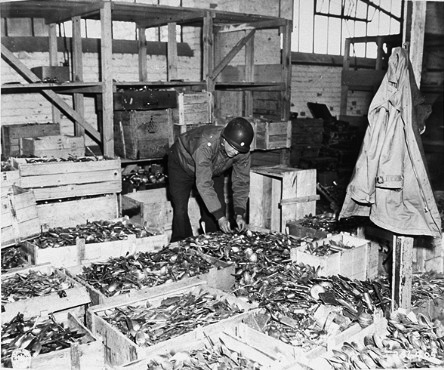Buchenwald Concentration Camp MuseumThe storehouse building at the former Buchenwald concentration camp was turned into a museum about the camp by the former East German government in 1985. In 1995, after the fall of Communism, the original museum was redone. The photograph above shows the posters near the entrance at the start of the museum displays in 1999. The huge photograph on the display panel to the left in the photo above shows a well-dressed Jewish man and woman with a yellow star sewn to their clothing; the Nazis revived this Medieval custom as the first step in their persecution of the Jews. This photograph is a still picture from a movie taken when the Dutch Jews were rounded up and sent to the death camps in what is now Poland. Around 600 Dutch Resistance fighters were sent to Buchenwald during the German occupation of the Netherlands. The storehouse building in the Buchenwald camp, completed in 1939, which is now the museum, was originally where the prisoner's civilian clothing and personal effects were kept. Incoming inmates had to leave all their possessions behind in this building.  When I visited in 1999, the Buchenwald museum exhibits were arranged in sections. The first section was entitled "...Right in the Midst of the German People." This section features information written on large posters in both German and English. In marked contrast to the museum at Dachau in the former West Germany, which told the story of the Nazi regime in an objective presentation in 1999, the Buchenwald museum still had the unmistakable biased viewpoint of the Communists in the former East Germany. The Dachau museum, which was set up in 1965, started with a lengthy display of the events leading up to the Third Reich, while the Buchenwald museum in 1999 glossed over the reasons for the Nazi rise to power. The 1965 Dachau museum had a vast display of photographs, but there were virtually none in the Buchenwald museum in 1999. Commandant Karl Koch established a photography department at Buchenwald, and the SS guards took numerous photographs of the camp including pictures of executions. However, most of them were destroyed when the building burned down during an Allied bombing raid on August 24, 1944. Mostly, the museum displays feature artifacts recovered from the camp, such as dishes used by the SS guards, combs, shoes, cigarette boxes, gray enameled soup bowls, carved wooden chess sets and a reconstructed whipping block used for prisoner punishment until 1942 when Reichsführer Heinrich Himmler ordered this punishment to stop. A large diesel engine was on display in the museum in 1999, as shown in the picture below. This engine was probably used in a submarine. Among the items on display in the Buchenwald museum in 1999 was a blue and grey striped uniform like the ones that the prisoners were forced to wear. The uniform had the prisoner's number and a colored triangle to designate the prisoner's category. The majority of the prisoners wore a red triangle to indicate that they were political prisoners, mostly Communists and Social Democrats. The common criminals wore a green triangle and the asocials were identified by a black triangle. Homosexuals wore pink and the work-shy wore a white triangle. The Gypsies wore a brown triangle. Jews wore two triangles, one of yellow to indicate their race, and another to designate their category. The two colored triangles were sewn together, one on top of the other, to form a 6 point star. Green over yellow meant a Jewish criminal and red over yellow designated a Jewish political prisoner. Most of the Jews were political prisoners who wore a red triangle over a yellow one. Conspicuously absent in the Buchenwald museum in 1999 was any evidence of the atrocities that were so widely publicized after the camp was liberated. The lamp shades made out of human skin were nowhere to be seen and there was not even a photo of them. Likewise, the shrunken heads and the soap made of human fat were missing. All of these items, which were displayed at the Nuremberg International Military Tribunal in 1946 and at the American Military Tribunal for the Buchenwald staff members in 1947, have apparently disappeared and there were no photographs, nor any mention of them at all in the Buchenwald museum, although there was a plaque on the wall in one of the rooms at the crematorium which told visitors that skin for the lamp shades was cut from the bodies of dead prisoners in that very room. Buchenwald Art GalleryHomeThis page was last updated on September 14, 2009 |